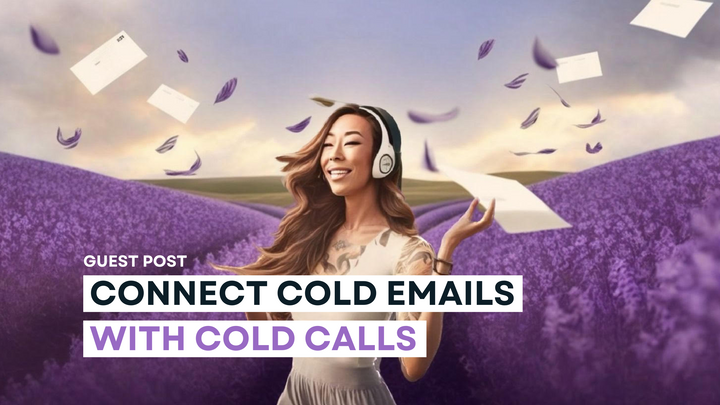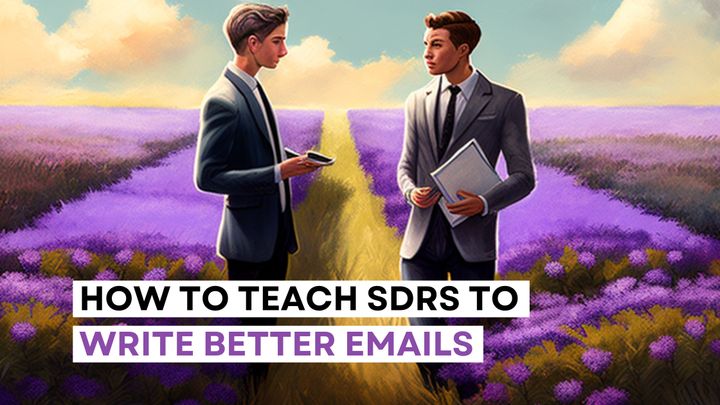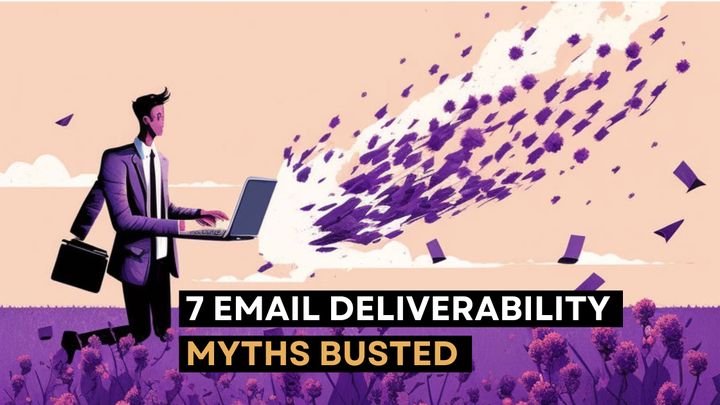9 Common Sales Email Mistakes and Lessons
Learning from mistakes is the best way to get better in sales (and in life). We rounded up 9 common email mistakes and what to do instead.

The best way to get better at your job costs $0.
Ready?
Make mistakes and learn from them.
Mistakes sometimes get a bad rap. But it’s how we learn and grow.
When writing emails, it’s fair to say we’ve all made mistakes.
How we learn from them is what makes the difference.
That’s why we created this list of email mishaps and lessons learned. Be warned, these mistakes might spark some bad memories. Best case, you can learn from our collective failures and avoid some serious email faux pas.
Common Sales Email Mistakes and What to Do Instead
1. Weak subject lines
Raise your hand if you’ve ever sent a cold email with a first name in the subject line.

What about a number, question, or “re:”?
Ever send one with “Hoping to connect?” or “Quick Question”?
🙈 Yup, us too. Our data says these will tank your reply rates. Here’s what to include in your subject line instead:
- Describe what the email is about. (e.g., “Personalization Issues”)
- Be Boring. Neutral tones work best. Avoid emotional words (e.g., “better” or “struggling”). Use factual, objective words. (e.g., “Reply Rates”)
- Use a short, one to three-word subject line. Two-word subject lines are optimal, according to our data.
- Title case (capitalizing the first letter of each word)
- Make it sound like an internal email. What would you write if this email was going to a colleague? It’s typically something short and descriptive. (e.g., “Template Revision”)
You also want to avoid these in your subject line:
- Punctuation (especially a “?” or “!”)
- Commands (e.g., “improve”)
- Superlatives (e.g., “better”)
- Clichés (e.g., “15 Minutes?”)
2. Writing the wrong recipient name
You may copy and paste the email copy and forget to change the recipient's name. Or perhaps you forgot a bracket when writing a {first name} token to auto-populate the recipient’s name. Whatever the reason, we’ve all been there.
Our main tip for this one: slow down. Pause to review every email before sending it. Polishing an email to potentially get a reply is worth the 15 seconds it took to read it. (If it takes longer, your email is probably too long)
Pro tip: Lavender has a misspelled name checker to catch a misspelling.
3. Giving up after one or two emails
We get it, sales is hard. After sending an email or two and receiving no reply, it’s understandable you might want to move on.
Sometimes the person you’re emailing is the wrong person, your solution isn’t a priority, or they could have just missed your email. There are many reasons why you may not get a reply.
Don’t throw in the towel after two emails. The fortune is in the follow-up.
These situations are exactly why you need a sales email cadence. Here’s how to build one that gets results.
4. Writing lengthy emails
We know the scenario: You found the precise decision-maker to email at a big company. You’re enthusiastic about your product and how it can help your buyer.
You spend 20 minutes crafting an email that perfectly captures all the reasons they should use your solution. Here’s the problem, it’s five paragraphs … too long.

For all sales emails, shorter is better.
Emails that are short and mobile-optimized see 83% more replies. (An email has to be short to be easily read on a mobile device. Think about reading an email on your phone without needing to scroll; that’s the ideal state for every email.)
Our data also confirm the fewer words you use, the higher your reply rate.
Aim for 25-75 words total (not including the subject line). While this sounds short, remember your reader is busy. They’ll only scan yours for 9 seconds on average.
5. Not keeping the focus on the reader
You’re likely writing a cold email to see if the recipient is interested in buying your product. So it’s understandable you’d want to tell them about what you do.
However, that’s the last thing you want to do.
Imagine a stranger approaching you at a party and talking about themselves incessantly. Or even worse, imagine they immediately asked you to buy something. How does that feel?
The same experience happens when you write three paragraphs about your product and include bullet points about its features.
Your reader doesn’t care. They’re in their inbox, focused on their priorities and to-do list.
Keep the focus on your reader. Consider these questions:
- Why are you writing to them?
- What problem do they have that you can solve?
- How can you solve that problem?
- Can you share how you’ve helped other people like them solve similar challenges?
- Did you make it easy to reply?
These email frameworks may help work through this.
6. Sending too many emails in one day
It’s the end of the month, and you’re behind in meeting your quota. Time to fire off a hundred emails, right?

Wrong. Mass emailing is one of the biggest mistakes people make.
It’s a serious one because it can torch your deliverability. This term refers to the ability to deliver emails to people’s inboxes. Many factors determine whether your email will land in a recipient’s inbox or spam folder.
A big factor can be the words you use. If you start your email with a phrase like “Hey, I know you get a lot of SPAM. This isn’t that.” your email might land in the SPAM folder just because you mentioned SPAM!
Pro tip: Lavender actively monitors your word choice to protect your emails from landing in the spam folder.
When you send a significant amount of emails in a short period, it can damage your domain’s reputation. Your domain reputation is a key factor in your ability to land in the inbox.
This behavior can also impact everyone who shares the same email domain (the URL that follows the “@” in your email) at your company. You could all experience difficulty landing in anyone’s inbox, and your emails may go straight to the spam folder.
Imagine your CEO’s response when they find out no one is getting their emails because a sales rep blasted 500 potential customers with an email. (not good)
While there are more advanced options (like creating and using multiple domains), here are some good rules of thumb:
- Focus on keeping your reply rates > 10%
- Avoid sending over 50 emails per day
- Avoid hyperlinking (especially trackable links)
- Don’t send images, bolding, italics, or anything that could add HTML to the email.
While your IT team needs to ensure your emails are correctly connected, if you focus on sending high-quality emails, you shouldn’t have a problem.
Pro tip: Monitor changes in your open rates to catch any potential deliverability issues.
7. Spilling all the beans right away
One of the most common mistakes is dumping everything you have to say into your first email.
Your email isn’t an Eminem song. If you remember to follow up correctly, you have more than “one shot, one opportunity.”
Your first-touch email doesn’t have to work the hardest. As our COO and co-founder Will Allred often says, you don’t want to “spill all your candy” immediately.
You have nothing to say in your follow-up emails when you do this. So you’re left writing things like “just following up, “checking in,” and “wanting to see if you saw my previous email.”
Those statements aren’t effective because they don’t remind the reader why you’re showing up and why they should care.
Think about creating a magnet-like “pull” with your first email. You’re reaching out because you think you can help them.
Your email writing should always create a pull for the reader to dig deeper. You can achieve this by creating a smart cadence around why you’re reaching out, not what you do.
8. Using the wrong writing tone
Even THE great Jen Allen-Knuth has admitted to making this mistake.
You may think you need to sound formal, smart, informative, or authoritative. All of those tones will hurt your chance of receiving a reply.
These tones aren’t effective because they result in “talking at” your reader instead of “talking to” them.
It can be off-putting or distracting for your reader if you assume to know information or try to sound smart.
Our data shows using unsure tones increases your chance of receiving a reply. This is because you come across as curious versus informative.
This graph from our dashboard shows the reply rate when writing with a specific number of unsure sentences.
Here are some tips for creating an unsure tone:
- Ask questions
- Use conditionals. These sentences discuss a hypothetical situation, including “if” statements.
- Use hedge words, which express uncertainty with words like perhaps, think, probably, usually, etc.
- Use passive language. This is when a sentence’s subject receives the verb's action; these typically contain “by.”
- Use language that implies questions. E.g., “Let me know if you’d like more information.”
9. Emailing the wrong person
When we asked our friends on LinkedIn to share their email mistakes, this one came up a lot.

It’s an easy one to make!
Perhaps you were confident you found the right prospect to email, only to be met with a “wrong person” or no reply.
The solution to this is honing your research and personalization skills.
- Create an email personalization process that works for you
- Avoid over-personalization (e.g., If you found ten helpful facts about your buyer, don’t mention them all in the first email)
- If you’re working with little to no data, start with the segmentation info you do have and build from there. (And follow the rest of this personalization process.)
Bonus:
10. Not using Lavender ;)
Our suite of tools helps thousands of sellers worldwide write better emails faster and double their positive reply rates.
We analyze millions of emails to understand what generates replies and what doesn’t. That data give you specific suggestions and tips for improving your emails to maximize results. We help you send better emails and improve your writing with every send.
Video more your style? Will Aitken talks to four buyers and gets their reactions to bad cold emails. Tune in for insights, laughs, and tips.




